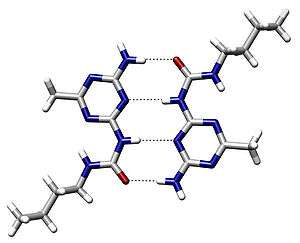Supramolecular polymers

A supramolecular polymer is a polymer whose monomer repeat units are held together by noncovalent bonds. Non-covalent forces that hold supramolecular polymers together include coordination, π-π interactions, and hydrogen bonding. Supramolecular polymers can have physical properties similar to plastic materials, while having better processability and better recycling and self-healing[1] properties, thanks to their reversible transition from monomer to polymer structure.[2][3]
One system that has been demonstrated uses quadruple hydrogen bonds to form supramolecular polymers.[4] Functionalization of polymers with the quadruple hydrogen bonding unit from the Meijer group introduces reversible cross-links and a virtual increase in the polymer’s molecular weight. In general, polymers with a higher molecular weight possess better material properties.
References
- ↑ Burnworth, Mark; Tang, Liming; Kumpfer, Justin R.; Duncan, Andrew J.; Beyer, Frederick L.; Fiore, Gina L.; Rowan, Stuart J.; Weder, Christoph (2011). "Optically healable supramolecular polymers". Nature. 472 (7343): 334–337. doi:10.1038/nature09963. ISSN 0028-0836.
- ↑ de Greef, Tom F. A.; Meijer, E. W. (2008). "Materials science: Supramolecular polymers". Nature. 453 (7192): 171–173. doi:10.1038/453171a. ISSN 0028-0836.
- ↑ Aida, T.; Meijer, E. W.; Stupp, S. I. (2012). "Functional Supramolecular Polymers". Science. 335 (6070): 813–817. doi:10.1126/science.1205962. ISSN 0036-8075.
- ↑ Ng, Chun-Fai; Chow, Hak-Fun (2015). "A supramolecular ladder polymer prepared by hydrogen bonding-mediated self-assembly of a metallomacrocycle". Chem. Commun. 51 (12): 2349–2352. doi:10.1039/C4CC08817D. ISSN 1359-7345.